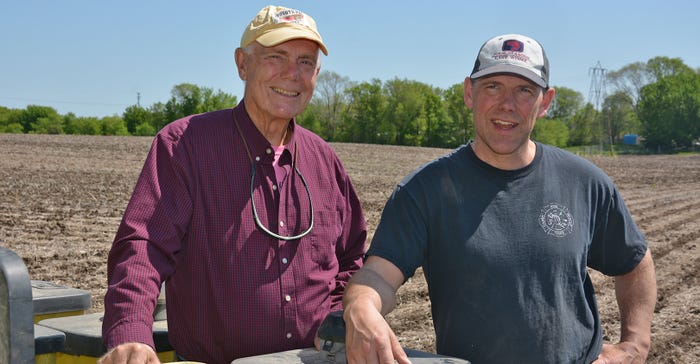
For Dave Legvold, the teachable moment never ends.
The former teacher-turned-farmer welcomes anyone to visit his operation. He hosts students from Northfield schools and nearby St. Olaf and Carleton colleges, who visit and conduct research projects on his farm.
Now Legvold has added another instructional activity to his list: serving as one of The Fertilizer Institute’s 2017 4R advocates. Advocates are selected to help educate other farmers about the 4Rs — applying the right source of nutrients at the right rate, the right time and in the right place to optimize crop production and benefit the environment.
For the upcoming year, Legvold shares 4R advocate responsibilities in Minnesota with his agronomist, Ken Thomas, at Farmers Mill and Elevator, Castle Rock. Since 2012, the 4R Advocate Program has recognized 25 ag producers and retailers farming 131,225 acres in 15 states.
“When we use fertilizer properly, it benefits the environment,” Legvold says. “Using no-till technology and the chemistry that goes along with it to enhance my weed control allows the soil to convert nutrients more effectively. Over the years, I have cut my fertilizer use by a third, and the crops continue to do well.”
Legvold farms 800 acres of corn and soybeans with his wife, Ruth; sons Michael and Mark; and friend Marvin Perez. Over his four decades of farming, he has relied on farm advisers and research data to guide his crop management decisions. In fact, he expands on the 4R concept by adding a fifth R — research.
“Farmers need to think about using the right product in the right place at the right rate at the right time. Those are all important concepts to follow,” Legvold says. “For me, there is a fifth R, and that’s research. How do we know if something is centered on the 4Rs or if it works? We need research to help prove it does.”
Following the 4R philosophy
To understand what products are available for his operation, Legvold routinely meets with Thomas in late winter or early spring to discuss new agronomic products, fertilizer applications and technology advancements. Then they develop an agronomic plan, including specifics about nutrient management.
“I work on rate of removal — how much does it take to grow a crop?” Legvold says. “I don’t aim for high-test P or K.”
Typically, he uses dry fertilizer, applied with his SoilWarrior that does strip tillage.
“We’ll sidedress N in-season,” he adds. “Split application is the way to go. I never put N on in the fall.” He uses liquid N when sidedressing and places it into the soil. Sidedressing N begins at V5 to V8 as conditions allow.
He appreciates the performance of the strip-till machine, manufactured by Environmental Tillage Systems in Faribault. He can accurately place fertilizer 2 inches below the seed in-row with it. Plus, the machine preserves huge amounts of residue, providing adequate mulch for the growing season that then decomposes and enriches the soil.
When planning fertilizer rates, Legvold considers the recommendations of the Iowa State University nitrogen rate calculator.
“Over the years, we’ve used this calculator as our baseline number that that we shoot for: the MRTN, or maximum return to nitrogen,” he says. “In general, if you aim for this number, you’ll attain the best economic outcome.”
Soil sampling is an important piece of Legvold’s management strategy. Since he places fertilizer in the zone, that’s where he takes soil samples because that’s where plants get their nutrients.
“We decided on this procedure after many hours of discussion and deliberation with students,” Legvold says. “We then did four years of testing to verify that zone testing was as accurate as any other method.”
Soil organic matter on his strip-till crop acres continues to improve, too. Land he rents from St. Olaf College had been in continuous corn tilled with moldboard plow for the previous three decades. Over the past 14 years, organic matter in that field has increased from 1.7% to 5.5% and 6.5%.
Underlying Legvold’s farming practices is a deeply held environmental goal: to develop and maintain healthy soils while protecting groundwater and surface water. Since his farm slopes toward a Category 3 stream, runoff is an important consideration. His farm has been accepted into the Minnesota Agricultural Water Quality Certification Program, and last year, he was recognized as an agricultural "Water Hero" by Gov. Mark Dayton.
"Things we were sure of about in farming 25 years ago may no longer hold true,” Legvold concludes. “We must move toward practices that build soil, protect water and air, and find proof through on-farm research."
About the Author(s)
You May Also Like






